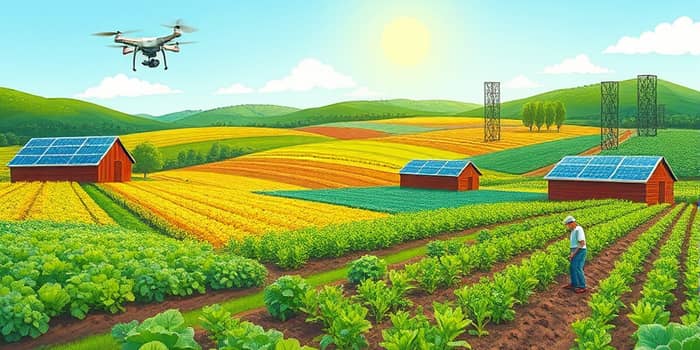
As the global population nears eight billion, the imperative to cultivate resilient food systems has never been greater. Traditional agriculture strains finite resources and accelerates environmental degradation, threatening both productivity and ecological balance. In response, a surge of innovation and investment is driving a transformation toward sustainable models that prioritize soil health, resource efficiency, and long-term resilience.
By aligning economic incentives with environmental stewardship, stakeholders—from smallholder farmers to institutional investors—are redefining what it means to feed the world. This article explores the expanding market, breakthrough practices, investment channels, policy levers, and the intertwined challenges and opportunities shaping sustainable agriculture’s ascent.
Recent forecasts project the sustainable agriculture market size will reach $16.75 billion in 2025, up from $15.07 billion in 2024. With an 11.2% compound annual growth rate, this sector is capturing capital across regions. Global investment volumes are expected to surpass $30 billion by 2025, drawn by the promise of climate-smart innovations and practices that enhance yields while reducing carbon footprints.
Organic farming continues to expand, with over 75 million hectares under cultivation worldwide. Major geographies—Europe, India, the United States, and Latin America—lead this growth. In the U.S., more than 60% of farmland investment funds now integrate sustainable criteria, underscoring a shift toward lasting ecological and financial returns.
Cutting-edge techniques are redefining farm management and resource stewardship. By leveraging technology and ecosystem-based approaches, producers can nurture healthy soils, conserve water, and boost productivity.
Investors can access a diverse range of vehicles, each offering unique risk-return profiles and sustainability benefits. Whether seeking steady income from farmland or high-growth tech ventures, capital deployment can drive both financial and environmental dividends.
In the United States, dedicated farmland investment funds—such as Gladstone Land Corporation, Farmland Partners Inc., and specialized sustainable agriculture funds—are delivering returns between 6.5% and 9.2%. These vehicles prioritize water conservation, carbon sequestration, and ESG criteria, demonstrating that ecological responsibility and profitability can go hand in hand.
Rising demand for nutritious food strains existing systems, while climate change exacerbates volatility. Today, 25–30% of food is lost or wasted post-harvest, representing both a humanitarian and environmental crisis. Reducing this waste could slash agricultural greenhouse gas emissions by up to 10%.
By integrating sustainable practices, stakeholders can foster resilient food systems with balanced productivity and equity. Techniques such as smart intensification—which closes yield gaps without expanding farmland—are crucial. Moreover, alternative proteins and optimized feed strategies reduce pressure on arable land and lower methane emissions from livestock.
Governments worldwide are enacting frameworks to accelerate sustainable adoption. Organic certification standards are tightening, carbon credit systems are emerging, and public incentives now reward fair trade and ecosystem restoration. Institutional investors are also responding to ESG mandates, channeling capital into climate-smart agriculture.
These measures lower financial barriers and de-risk investments, ultimately making sustainable solutions more accessible to producers of all scales.
While progress is encouraging, significant hurdles remain. Achieving a balance between maximizing yields and honoring ecological limits is complex. Climate-related risks—such as extreme weather and shifting pest pressures—threaten crop stability. Without rapid scale-up of sustainable methods, 30% of global farmland faces severe degradation by 2025.
Another critical challenge is ensuring that smallholder farmers and communities in developing regions benefit from technological advances and capital flows. Inclusive growth requires tailored financing, capacity-building programs, and robust knowledge-sharing networks.
Looking ahead, multi-stakeholder collaboration will define success. By fostering partnerships between governments, private investors, researchers, and farmers, the sector can refine scalable models that optimize resource use, enhance biodiversity, and secure livelihoods.
The rise of sustainable agriculture represents a pivotal opportunity to align economic growth with planetary health. Through strategic investments, cutting-edge practices, and supportive policies, stakeholders can build food systems that feed a burgeoning population without forsaking the environment. By embracing holistic, science-driven solutions for long-term food security, we can sow the seeds of a resilient future, ensuring that generations to come inherit rich soils, thriving ecosystems, and abundant harvests.
References













